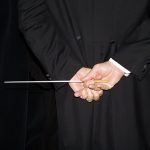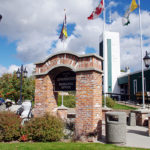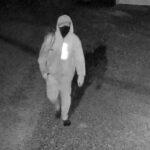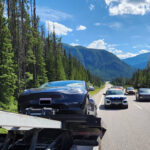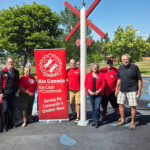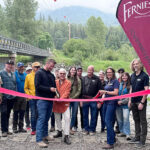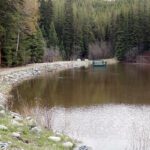Home »
Interview with Canal Flats artist Leslie Cartwright
By Bob Ede/Photo by Lisa Ede
When I asked artist Leslie Cartwright if I could interview her for e-KNOW she agreed immediately. It was opening night of Pynelogs Cultural Centre and the building was packed. Pynelogs was hosting an open-themed show and several artists were showing work ranging from paintings, sculpture and photography. I didn’t want to take Leslie’s attention away from the many art lovers browsing the gallery that night, yet Leslie graciously gave me her time, even stepping outside for a quick photo.

I was somewhat familiar with Leslie’s work; knowing she was raised and lives at the headwaters of the Columbia River in the town of Canal Flats. Her paintings portray realistic renditions of valley wildlife and reveal an unmistakable connection to place. It is easy to see her paintings were of the area she both loved and was familiar with.
Leslie could be labeled an emerging artist, yet that would not be entirely true, as she has been creating art in various mediums for as long as she remembers.
The show runs at Pynelogs until June 17. Below are a few questions I asked Leslie about her art and the creative process.
BE: Thank you so much for doing this Leslie. When did you start painting?
Leslie Cartwright: When I was 11, a neighbour offered to give me a few lessons in oil painting. I remember standing at an easel in her living room, watching a tape recorded video of Bob Ross! At 13 I had weekly instruction in a group setting by a local artist, Linda Forsythe. At 19, I tried my hand at watercolour with Joyce Cornelson of Invermere. Joyce, at that time had her own gallery on main street in Invermere called ‘Paradise Art Shop.’ I basically retired my  paintbrushes once I started having children. I haven’t done much painting in the past 10 years, except to make some little Christmas ornaments. In the winter of 2011, I purchased an instructional video called ‘Painting Wildlife in Acrylic’ by Terry Isaac. I had learned of his art from a friend I worked with, she had leant me his book and I was very interested in the way that he had captured such fine detail and light in his paintings. While studying his book and DVD, I completed my first painting in a decade called “Rocky Mountain Monarch.” (Big Horn Sheep @ Pynelogs) Soon after, I learned that Terry Isaac would be teaching a five-day workshop in Cranbrook in October of 2011. I signed up for it immediately. It was a great experience. I have since kept in contact with Terry and I will be participating in an advanced workshop that he will instruct this October in his gallery in Penticton.
paintbrushes once I started having children. I haven’t done much painting in the past 10 years, except to make some little Christmas ornaments. In the winter of 2011, I purchased an instructional video called ‘Painting Wildlife in Acrylic’ by Terry Isaac. I had learned of his art from a friend I worked with, she had leant me his book and I was very interested in the way that he had captured such fine detail and light in his paintings. While studying his book and DVD, I completed my first painting in a decade called “Rocky Mountain Monarch.” (Big Horn Sheep @ Pynelogs) Soon after, I learned that Terry Isaac would be teaching a five-day workshop in Cranbrook in October of 2011. I signed up for it immediately. It was a great experience. I have since kept in contact with Terry and I will be participating in an advanced workshop that he will instruct this October in his gallery in Penticton.
BE: Your paintings on exhibit at Pynelogs are done with acrylic on canvas or board. Is this the medium you prefer and do you work in other mediums?
Leslie Cartwright: Two of my paintings, “Marmalade In The Morning,” and “Rocky Mountain Monarch” are acrylic on canvas. The third painting, “In My Mother’s Garden” is acrylic on cradled wood panel. I prefer acrylic paint over oils, so do my brushes! I illustrated my father’s book in pen, pencil and charcoal drawings and I still like to sketch in these mediums from time to time. I also enjoy working with wood. I have my grandfathers’ wood burner and I have burnt many images into benches, burls, plaques and unfortunately a few of my fingers!
BE: Your hometown of Canal Flats sits in a natural paradise. It is at the headwaters of the Columbia River and a short walk in any direction can immerse a person in solitude. Many of your paintings are very true to life. Is it this closeness to nature that allows you to be so realistic in your paintings?
Leslie Cartwright: The subjects and scenes that I paint are all from my own photographs for reference. I try to be as true to my reference as possible, though I endeavor to portray things the way the eye sees rather than the way the camera sees. I am constantly  observing and noting little details of light and how it reflects or casts shadows. Being able to immerse myself into nature and solitude mere footsteps from my door is a great advantage and inspiration to me.
observing and noting little details of light and how it reflects or casts shadows. Being able to immerse myself into nature and solitude mere footsteps from my door is a great advantage and inspiration to me.
BE: Your father, Colin Cartwright, is the author of two books, Empty on the Swan and Kootenay Bears. Both books, along with being a great read, serve as a historical record of the area. I believe being a historian runs in the blood. When you paint a painting or draw an illustration are you trying to preserve a record for future viewers?
Leslie Cartwright: When I paint, I am painting a scene or a subject that evokes a fond memory. I remember the exact moment that I took the photograph, where I was, what I was doing, and how I felt. I suppose I am trying to capture or preserve the essence of that moment.
BE: You illustrated the book Kootenay Bears. Your father is an exceptional storyteller with an eye that is both ‘forgiving’ and ‘matter of fact.’ What was it like working with your father?
Leslie Cartwright: It was great working with my father. I am happy to have had the chance to do something so special with him. For the most part my father gave me ‘free reign.’ As he completed his writing, he would give me a few chapters to read at a time. I then drew what I thought would encompass the highlights or climax of the story. My Dad and I would consult often, I wanted to make sure that he approved and was happy with the end result. If given the opportunity I would gladly do it again.
BE: Many of the illustrations in Kootenay Bears have a humorous, whimsical take on the subject. They fit perfectly with the stories. I could see your illustrations in a children’s book. Do you continue to do illustrations and are there plans for another book?
Leslie Cartwright: I have toyed with the idea of writing and illustrating my own children’s book. I have written quite a few verses but haven’t been able to finish the story; perhaps this is where I could employ some advice and assistance from my father!
BE: When I look at your painting ‘Colours on the Columbia’ I see this area. It is unmistakable. Your family has been in the valley for several generations. Do you consider that you may have the benefit of seeing these scenes, not just through your own eyes, but those of your parents and grandparents?
Leslie Cartwright: I am definitely very proud of my family name. When I see the platforms for the waterfowl along the Columbia wetlands in our valley, I am reminded that my grandparents were very much involved in preserving and protecting these habitats. I am thankful that my parents have instilled in me a great respect for nature and wildlife and I hope that my art will reflect this.
BE: Where can people see your artwork? Do you have any shows or exhibits planned for summer?
Leslie Cartwright: People can see my artwork at Pynelogs until June 17. I will also have some art in the VisArts 2012 Adjudicated CDAC exhibit and sale in Cranbrook at the Artrageous Art Gallery between June 12 and July 10. I will exhibit new art works at the Canal Flats Civic Centre on August 11 and 12, as part of the Columbia Basin Cultural Tour in the valley. As well, people can always check out my website at www.cartwrightart.blogspot.com.
BE: My mother painted when I was a small boy. I remember fondly waking to the smell of oil paints and finding a beautifully painted portrait on the easel. You have three young sons, what do they think of your artwork?
Leslie Cartwright: My children all enjoy drawing and making crafts. They are my biggest fans, especially when they want a car drawn so that they can colour it in! I must say that they’ve had some pretty elaborate birthday cakes! I guess you could add food colouring to one of my mediums!
Bob Ede spends his time cruising the backroads with a blind Terrier and a yappy Wire-haired Dachshund riding shotgun. The above interview is the first of a series of conversations with long time locals that will run in e-KNOW. He can be reached at: [email protected].

